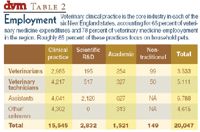New England veterinary market worth $3.3 billion
North Grafton, Mass. - For every 100 veterinary medical jobs in New England, an additional 59 jobs are created in related industries.
North Grafton, Mass. — For every 100 veterinary medical jobs in New England, an additional 59 jobs are created in related industries.
That statistic and others come from a study released this month that gauges veterinary medicine's economic significance in New England's six-state region. According to the report, researched by the University of Massachusetts Donahue Institute and commissioned by Tuft University's Cummings School of Veterinary Medicine, the profession pumps $3.3 billion into New England economies, with 65 percent of that generated by clinical practice (see Table 1).

Table 1
Outlining veterinary medicine's economic contributions might emphasize the profession's significance, especially in the minds of lawmakers, explains Dr. Deborah Kochevar, dean of Tuft's veterinary medical program.
"We're finding that people don't understand the breadth of the profession and its economic impact," she says. "We want our state veterinary medical associations to be able to better educate people by using these statistics. If it allows them to develop better legislative relationships in their respective states, that's great."
The data
The fruits of those relationships, Kochevar hopes, eventually will include funds to expand New England's only veterinary medical program. While pundits from across the country predict a national, even global shortage of DVMs, "Veterinary Medicine in New England: State-by-State Industry Characteristics and Economic Impacts" forecasts 1,036 regional vacancies for veterinarians by 2014, provided by new job creation and an aging work force. With an average 60 percent of new graduates remaining in New England (the school churns out approximately 82 new veterinarians each year), trend data estimate 658 new vacancies, creating a deficit of DVMs.

Table 2
That future shortage appears to extend beyond clinical practice, which accounts for 78 percent of veterinary medicine employment in the region.
Commercial scientific research and development, including pharmaceutical research and development, requires animal-health and husbandry services provided by DVMs, the study shows.
"The market for veterinary scientists and pathologists is huge and absolutely is growing," Kochevar says. "I'm impressed by how much the veterinary medical profession gives to the biotech industry. It serves pharmaceutical and medical device companies in key ways."
Expenditures in scientific research and development top $400,000 annually, accounting for 23.5 percent of total veterinary medicine spending. Fourteen percent of New England's veterinary-medicine employment comes from that sector.
Needy area
By contrast, food-animal veterinary medicine seems a vanishing sector, overshadowed by a huge majority of clinical small-animal practitioners (from 67 percent in Vermont to 92 percent in Rhode Island). Just one veterinarian registered with the American Veterinary Medical Association treats food animals exclusively.

Table 3
That statistic is deceiving, Kochevar says, given the size of the state: "You drive for 30 minutes and you're not in Rhode Island anymore." Yet just 116, or 3.8 percent, of practitioners work with food animals in the entire region, the report says.
Future directives
That kind of information coupled with statistics on topics like rising pet ownership and lower pay for women — a gender that now dominates the profession (see Table 4) — attracts the public's attention, Kochevar says. She wants to continually monitor key variables highlighted in the report about the region and the profession.
"What I propose is pulling out a dashboard of statistical indicators and updating them on regular intervals," she says.
"I think this type of data brings people closer to the school and illustrates the breadth of veterinary medicine."